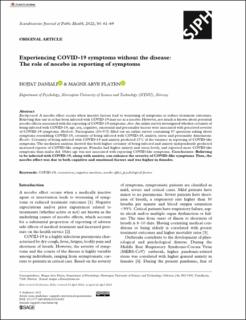| dc.contributor.author | Daniali, Hojjat | |
| dc.contributor.author | Flaten, Magne Arve | |
| dc.date.accessioned | 2022-04-05T07:53:17Z | |
| dc.date.available | 2022-04-05T07:53:17Z | |
| dc.date.created | 2021-05-27T14:30:34Z | |
| dc.date.issued | 2021 | |
| dc.identifier.citation | Scandinavian Journal of Public Health. 2021, 50 (1), 61-69. | en_US |
| dc.identifier.issn | 1403-4948 | |
| dc.identifier.uri | https://hdl.handle.net/11250/2989792 | |
| dc.description.abstract | Background:
A nocebo effect occurs when inactive factors lead to worsening of symptoms or reduce treatment outcomes. Believing that one is or has been infected with COVID-19 may act as a nocebo. However, not much is known about potential nocebo effects associated with the reporting of COVID-19 symptoms.
Aim:
An online survey investigated whether certainty of being infected with COVID-19, age, sex, cognitive, emotional and personality factors were associated with perceived severity of COVID-19 symptoms.
Methods:
Participants (N=375) filled out an online survey containing 57 questions asking about symptoms resembling COVID-19, certainty of being infected with COVID-19, anxiety, stress and personality dimensions.
Results:
Certainty of being infected with COVID-19 and anxiety predicted 27% of the variance in reporting of COVID-like symptoms. The mediation analysis showed that both higher certainty of being infected and anxiety independently predicted increased reports of COVID-like symptom. Females had higher anxiety and stress levels, and reported more COVID-like symptoms than males did. Older age was not associated with reporting COVID-like symptoms.
Conclusions:
Believing to be infected with COVID-19, along with anxiety, can enhance the severity of COVID-like symptoms. Thus, the nocebo effect was due to both cognitive and emotional factors and was higher in females. | en_US |
| dc.language.iso | eng | en_US |
| dc.publisher | SAGE Publications | en_US |
| dc.rights | Navngivelse 4.0 Internasjonal | * |
| dc.rights.uri | http://creativecommons.org/licenses/by/4.0/deed.no | * |
| dc.title | Experiencing COVID-19 symptoms without the disease: The role of nocebo in reporting of symptoms | en_US |
| dc.type | Peer reviewed | en_US |
| dc.type | Journal article | en_US |
| dc.description.version | publishedVersion | en_US |
| dc.source.pagenumber | 61-69 | en_US |
| dc.source.volume | 50 | en_US |
| dc.source.journal | Scandinavian Journal of Public Health | en_US |
| dc.source.issue | 1 | en_US |
| dc.identifier.doi | 10.1177/14034948211018385 | |
| dc.identifier.cristin | 1912275 | |
| cristin.ispublished | true | |
| cristin.fulltext | original | |
| cristin.qualitycode | 1 | |

